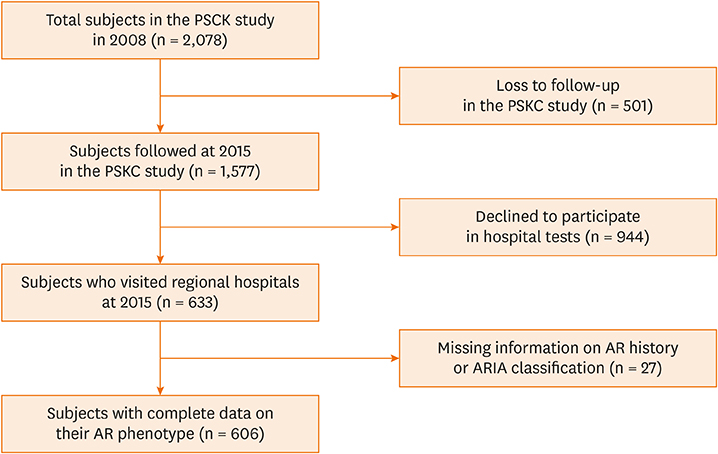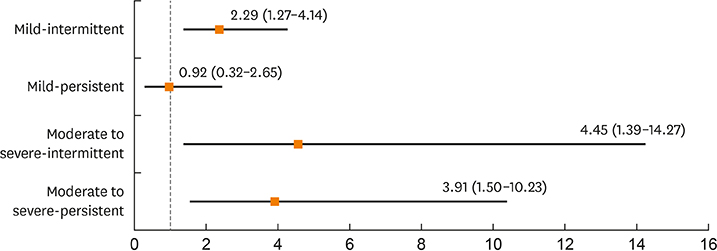Allergy Asthma Immunol Res.
2020 Jan;12(1):72-85. 10.4168/aair.2020.12.1.72.
Risk Factors and Comorbidities Associated With the Allergic Rhinitis Phenotype in Children According to the ARIA Classification
- Affiliations
-
- 1Department of Pediatrics, Pusan National University Yangsan Hospital, Yangsan, Korea.
- 2Department of Pediatrics, Childhood Asthma Atopy Center, Environmental Health Center, Asan Medical Center, University of Ulsan College of Medicine, Seoul, Korea. sjhong@amc.seoul.kr
- 3Department of Pediatrics, Mediplex Sejong Hospital, Incheon, Korea.
- 4Department of Pediatrics, International St. Mary's Hospital, Catholic Kwandong University Hospital, Incheon, Korea.
- 5Department of Pediatrics, Seoul National University College of Medicine, Seoul, Korea.
- 6Department of Pediatrics, Hallym University Sacred Heart Hospital, Hallym University College of Medicine, Anyang, Korea.
- 7Department of Pediatrics, Seoul National University Bundang Hospital, Seongnam, Korea.
- 8Department of Pediatrics, National Health Insurance Service Ilsan Hospital, Ilsan, Korea.
- 9Department of Pediatrics, Gachon University Gil Medical Center, Incheon, Korea.
- 10Department of Pediatrics, College of Medicine, Chungbuk National University, Cheongju, Korea.
- 11Department of Pediatrics, The Catholic University of Korea College of Medicine, Daejeon, Korea.
- 12Department of Pediatrics, Presbyterian Medical Center, Jeonju, Korea.
- 13Department of Pediatrics, Chonnam National University Medical School, Chonnam National University Hospital, Gwangju, Korea.
- 14Department of Pediatrics, Gwangju Veterans Hospital, Gwangju, Korea.
- 15Department of Pediatrics, Catholic University of Daegu School of Medicine, Deagu, Korea.
- 16Department of Pediatrics, University of Ulsan College of Medicine, Ulsan University Hospital, Ulsan, Korea.
- 17Department of Pediatrics, Dong-A University College of Medicine, Busan, Korea.
- 18Department of Pediatrics, Health Science Institute, Gyeongsang National University College of Medicine, Jinju, Korea.
- 19Division of Allergy and Chronic Respiratory Diseases, Center for Biomedical Sciences, Korea National Institute of Health, Korea Centers for Disease Control and Prevention, Cheongju, Korea.
- 20Korea Institute of Child Care and Education, Seoul, Korea.
- KMID: 2462573
- DOI: http://doi.org/10.4168/aair.2020.12.1.72
Abstract
- PURPOSE
Data are lacking on the association between the allergic rhinitis (AR) phenotype and sensitization to specific allergens or bronchial hyperresponsiveness (BHR) in children. We here investigated risk factors and comorbidities, including sensitization to specific allergens and BHR, for the AR phenotype by AR and its Impact on Asthma (ARIA) classification in a general population-based birth cohort study.
METHODS
We enrolled 606 children aged 7 years from the Panel Study of Korean Children. The AR phenotype was assigned in accordance with the ARIA classification in children. Skin prick tests and Provocholine provocation test were performed. Risk factors and comorbidities for AR phenotypes were then analyzed.
RESULTS
The prevalence of mild and moderate to severe AR in our study cohort was 37.2% and 8.8%, respectively. Recent use of analgesics or antipyretics and current cat ownership were associated with the risk of mild persistent AR. Sensitizations to Dermatophagoides Pteronyssinus (Der p), Japanese hop and cat were associated with moderate to severe persistent AR. Children with moderate to severe AR had a higher risk of current asthma and BHR compared to mild AR cases (adjusted odds ratio [aOR], 5.26; 95% confidence interval [CI], 1.77-15.62). Moderate to severe AR with allergic sensitization was associated with the highest risk of BHR (aOR, 11.77; 95% CI, 3.40-40.74).
CONCLUSIONS
Moderate to severe-persistent AR is more closely related to respiratory comorbidities and sensitizations than mild AR. Stratifying the AR phenotype by ARIA classification may assist in disease management.
Keyword
MeSH Terms
-
Allergens
Analgesics
Animals
Antipyretics
Asian Continental Ancestry Group
Asthma
Bronchial Hyperreactivity
Cats
Child*
Classification*
Cohort Studies
Comorbidity*
Dermatophagoides pteronyssinus
Disease Management
Humans
Methacholine Chloride
Odds Ratio
Ownership
Parturition
Phenotype*
Prevalence
Rhinitis, Allergic*
Risk Factors*
Skin
Allergens
Analgesics
Antipyretics
Methacholine Chloride
Figure
Reference
-
1. Bousquet J, Khaltaev N, Cruz AA, Denburg J, Fokkens WJ, Togias A, et al. Allergic Rhinitis and its Impact on Asthma (ARIA) 2008 update (in collaboration with the World Health Organization, GA(2)LEN and AllerGen). Allergy. 2008; 63:Suppl 86. 8–160.2. Bousquet J, Schünemann HJ, Zuberbier T, Bachert C, Baena-Cagnani CE, Bousquet PJ, et al. Development and implementation of guidelines in allergic rhinitis – an ARIA-GA2LEN paper. Allergy. 2010; 65:1212–1221.3. Bousquet J, Heinzerling L, Bachert C, Papadopoulos NG, Bousquet PJ, Burney PG, et al. Practical guide to skin prick tests in allergy to aeroallergens. Allergy. 2012; 67:18–24.4. Brożek JL, Bousquet J, Agache I, Agarwal A, Bachert C, Bosnic-Anticevich S, et al. Allergic Rhinitis and its Impact on Asthma (ARIA) guidelines-2016 revision. J Allergy Clin Immunol. 2017; 140:950–958.5. Katelaris CH, Lee BW, Potter PC, Maspero JF, Cingi C, Lopatin A, et al. Prevalence and diversity of allergic rhinitis in regions of the world beyond Europe and North America. Clin Exp Allergy. 2012; 42:186–207.
Article6. Hong SJ, Ahn KM, Lee SY, Kim KE. The prevalences of asthma and allergic diseases in Korean children. Korean J Pediatr. 2008; 51:343–350.
Article7. Kim WK, Kwon JW, Seo JH, Kim HY, Yu J, Kim BJ, et al. Interaction between IL13 genotype and environmental factors in the risk for allergic rhinitis in Korean children. J Allergy Clin Immunol. 2012; 130:421–426.e5.
Article8. Lee Y, Choi J, Park MR, Kim J, Kim WK, Park YM, et al. Analysis of regional prevalence of allergic diseases in Korean school children. Allergy Asthma Respir Dis. 2015; 3:62–69.
Article9. Bahk J, Yun SC, Kim YM, Khang YH. Impact of unintended pregnancy on maternal mental health: a causal analysis using follow up data of the Panel Study on Korean Children (PSKC). BMC Pregnancy Childbirth. 2015; 15:85.
Article10. Jung S, Suh DI, Lee SY, Yoon J, Cho HJ, Kim YH, et al. Prevalence, risk factors and cutoff values for bronchial hyperresponsiveness to provocholine in 7-year-old children. Allergy Asthma Immunol Res. 2018; 10:466–477.
Article11. Pepys J. Skin tests for immediate, type I, allergic reactions. Proc R Soc Med. 1972; 65:271–272.12. Crapo RO, Casaburi R, Coates AL, Enright PL, Hankinson JL, Irvin CG, et al. Guidelines for methacholine and exercise challenge testing-1999. This official statement of the American Thoracic Society was adopted by the ATS Board of Directors, July 1999. Am J Respir Crit Care Med. 2000; 161:309–329.13. Worldwide variation in prevalence of symptoms of asthma, allergic rhinoconjunctivitis, and atopic eczema: ISAAC. The International Study of Asthma and Allergies in Childhood (ISAAC) Steering Committee. Lancet. 1998; 351:1225–1232.14. Lee SY, Kwon JW, Seo JH, Song YH, Kim BJ, Yu J, et al. Prevalence of atopy and allergic diseases in Korean children: associations with a farming environment and rural lifestyle. Int Arch Allergy Immunol. 2012; 158:168–174.
Article15. van Beijsterveldt CE, Boomsma DI. Genetics of parentally reported asthma, eczema and rhinitis in 5-yr-old twins. Eur Respir J. 2007; 29:516–521.
Article16. Illi S, Weber J, Zutavern A, Genuneit J, Schierl R, Strunz-Lehner C, et al. Perinatal influences on the development of asthma and atopy in childhood. Ann Allergy Asthma Immunol. 2014; 112:132–139.e1.
Article17. Thomson JA, Widjaja C, Darmaputra AA, Lowe A, Matheson MC, Bennett CM, et al. Early childhood infections and immunisation and the development of allergic disease in particular asthma in a high-risk cohort: a prospective study of allergy-prone children from birth to six years. Pediatr Allergy Immunol. 2010; 21:1076–1085.
Article18. Nwaru BI, Takkinen HM, Kaila M, Erkkola M, Ahonen S, Pekkanen J, et al. Food diversity in infancy and the risk of childhood asthma and allergies. J Allergy Clin Immunol. 2014; 133:1084–1091.
Article19. Magnusson J, Kull I, Rosenlund H, Håkansson N, Wolk A, Melén E, et al. Fish consumption in infancy and development of allergic disease up to age 12 y. Am J Clin Nutr. 2013; 97:1324–1330.
Article20. Strachan DP, Aït-Khaled N, Foliaki S, Mallol J, Odhiambo J, Pearce N, et al. Siblings, asthma, rhinoconjunctivitis and eczema: a worldwide perspective from the International Study of Asthma and Allergies in Childhood. Clin Exp Allergy. 2015; 45:126–136.
Article21. Strachan DP. Family size, infection and atopy: the first decade of the “hygiene hypothesis”. Thorax. 2000; 55:Suppl 1. S2–S10.
Article22. Park YB, Mo EK, Lee JY, Kim JH, Kim CH, Hyun IG, et al. Association between pet ownership and the sensitization to pet allergens in adults with various allergic diseases. Allergy Asthma Immunol Res. 2013; 5:295–300.
Article23. Kozyrskyj AL, Mai XM, McGrath P, Hayglass KT, Becker AB, Macneil B. Continued exposure to maternal distress in early life is associated with an increased risk of childhood asthma. Am J Respir Crit Care Med. 2008; 177:142–147.
Article24. Chung YJ, Cho IK, Lee KI, Bae SH, Lee JW, Chung PS, et al. Seasonal specificity of seasonal allergens and validation of the ARIA classification in Korea. Allergy Asthma Immunol Res. 2013; 5:75–80.
Article25. Antonicelli L, Micucci C, Voltolini S, Feliziani V, Senna GE, Di Blasi P, et al. Allergic rhinitis and asthma comorbidity: ARIA classification of rhinitis does not correlate with the prevalence of asthma. Clin Exp Allergy. 2007; 37:954–960.
Article26. Bousquet J, Annesi-Maesano I, Carat F, Léger D, Rugina M, Pribil C, et al. Characteristics of intermittent and persistent allergic rhinitis: DREAMS study group. Clin Exp Allergy. 2005; 35:728–732.
Article27. Pereira AM, Morais-Almeida M, Santos N, Nunes C, Bousquet J, Fonseca JA. Severity of rhinitis and wheezing is strongly associated in preschoolers: a population-based study. Pediatr Allergy Immunol. 2015; 26:618–627.
Article28. Di Cara G, Carelli A, Latini A, Panfili E, Bizzarri I, Ciprandi G, et al. Severity of allergic rhinitis and asthma development in children. World Allergy Organ J. 2015; 8:13.
Article29. Cuttitta G, Cibella F, La Grutta S, Hopps MR, Bucchieri S, Passalacqua G, et al. Non-specific bronchial hyper-responsiveness in children with allergic rhinitis: relationship with the atopic status. Pediatr Allergy Immunol. 2003; 14:458–463.
Article30. Shaaban R, Zureik M, Soussan D, Antó JM, Heinrich J, Janson C, et al. Allergic rhinitis and onset of bronchial hyperresponsiveness: a population-based study. Am J Respir Crit Care Med. 2007; 176:659–666.31. Ciprandi G, Cirillo I, Klersy C. Lower airways may also be affected in asymptomatic patients with recent onset of allergic rhinitis. Laryngoscope. 2010; 120:1288–1291.
Article32. Olivieri M, Mohaddes Zadeh MR, Talamini G, Lampronti G, Lo Cascio V. Local nasal immunotherapy and bronchial hyperreactivity in seasonal allergic rhinitis: an observational pilot study. J Investig Allergol Clin Immunol. 2000; 10:300–304.33. Corren J. The impact of allergic rhinitis on bronchial asthma. J Allergy Clin Immunol. 1998; 101:S352–6.
Article34. Bousquet J, Van Cauwenberge P, Khaltaev N. Aria Workshop Group. World Health Organization. Allergic rhinitis and its impact on asthma. J Allergy Clin Immunol. 2001; 108:S147–334.
Article35. Kim SW, Han DH, Lee SJ, Lee CH, Rhee CS. Bronchial hyperresponsiveness in pediatric rhinitis patients: the difference between allergic and nonallergic rhinitis. Am J Rhinol Allergy. 2013; 27:e63–8.
Article36. Choi SH, Yoo Y, Yu J, Rhee CS, Min YG, Koh YY. Bronchial hyperresponsiveness in young children with allergic rhinitis and its risk factors. Allergy. 2007; 62:1051–1056.
Article
- Full Text Links
- Actions
-
Cited
- CITED
-
- Close
- Share
- Similar articles
-
- Analysis of Allergic Rhinitis according to New Classification Regarded by ARIA(Allergic Rhinitis and its Impact on Asthma) Guideline : Difference with Classification by Antigen Detected by Multiple Allergen Simultaneous Test(MAST)
- Seasonal Specificity of Seasonal Allergens and Validation of the ARIA Classification in Korea
- Phenotypes of allergic diseases in children and their application in clinical situations
- Prevalence of Allergic Rhinitis on the Basis of ARIA Classification
- Prevalence, comorbidities, diagnosis, and treatment of nonallergic rhinitis: real-world comparison with allergic rhinitis




